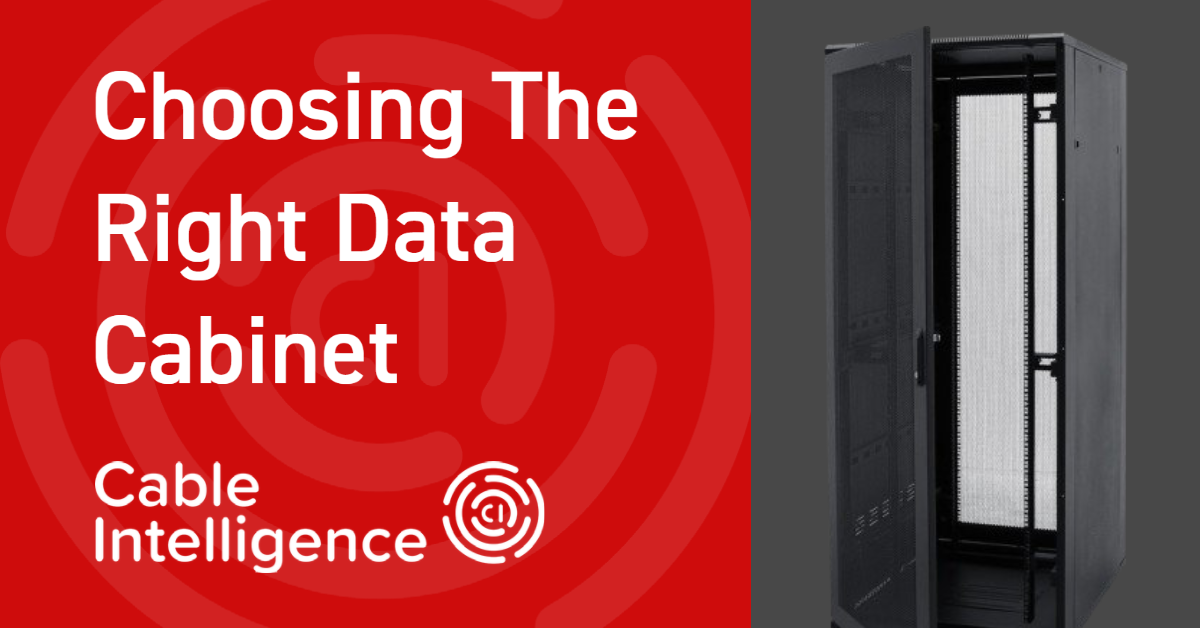In this blog post, we’ll be diving into the world of data cabinets. We’ll explain exactly what they are, how to choose the correct cabinet for your needs and taking a look at the different configuration options available to you as well as where to buy data cabinets. So, if you’re looking for somewhere to house your equipment, but don’t know where to start, this article is for you!
So, how does a data cabinet work? Essentially, cabinets allow for various pieces of equipment to be stored in a single enclosure. This allows for the efficient use of space, and also means that your expensive devices are secure and less likely to be damaged. Inside the cabinet is a framework, usually made of aluminium or steel, which has holes drilled into it to allow the mounting of equipment with screws or bolts.
The next question to ask yourself is: what size data cabinet do I need?
Height
One of the most important things to consider when you’re choosing your data cabinet is its height. This is because data cabinets, and in turn, the equipment that goes inside them is measured in a special unit, called a ‘U’ or Rack Unit. But what is a U in data cabinets? One U (usually stylized as 1U) is equal to 1.75 inches, or 44.45mm.
For example, you could have a 12U cabinet, and within it, you may have several pieces of equipment, such as a rack-mounted network switch, some rack-mounted PC’s and perhaps a monitor on a shelf along with a rack-mounted PSU that together equal less than or equal to 12U.
It’s worth noting that you should purchase a cabinet high enough for any future purchases and not just for the equipment you currently have, in order to save yourself space and money in the long run.
Width And Depth
The next thing to consider when choosing a cabinet is its width and depth. The industry standard width of the cabinet’s rails is 19”, and nearly all IT equipment is designed for this exact purpose. However, the cabinets themselves can be wider or deeper, depending on whether you require more room for cable management. At Cable Intelligence, we offer data cabinets that are either 600mm or 800mm wide and the same goes for depth. Again, the width and depth of the cabinet you choose should be dictated by the devices that go in them.
If you are looking for a server cabinet, these are usually deeper (1000mm) to provide the extra room that servers require, and often provide better ventilation, due to the increased heat created by these types of devices. You may also find that server manufacturers require the use of their own rail kit, so this is something to take note of.
Configuration
At Cable Intelligence, we are able to offer our cabinets both assembled or as a flat pack option. Most cabinets can be easily placed in their designated location, however, some areas may initially be hard to access and a large cabinet may not easily fit through a door or window. In this instance, it is better to buy the cabinet flat-packed, and it can then be assembled within the room it is to be situated in.
You may wish to add castors to your cabinet. In simple terms, castors are a way to add wheels to your cabinet, allowing you to easily move the whole thing – this may be useful if you need to move the cabinet around on a regular basis. We offer both standard and ‘jacking’ castors (the latter allows for the height of the cabinet to be increased or decreased).
Another optional extra for your cabinet is a data cabinet roof fan. A fan is essential if you are installing equipment that generates excess heat, such as a rack-mounted power supply unit, so that it can be cooled.
Doors and side panels can also be removed if access is constantly required and security is not a concern (it goes without saying that if the door is removed, the cabinet is no longer secured behind a lock).
Accessories
There are various accessories that we have not already mentioned, that you can purchase for your new cabinet to make life easier when installing equipment inside of it.
Rack Mounted PDU's
These are often surge protected and allow you to plug your equipment into one central location. This allows for much easier power cable management.
Shelving
Various styles of shelving are available to install in your cabinet for equipment that isn’t rack-mountable. Cabinet shelving allows for a sturdy base to sit your equipment on, and often contains holes and vents for extra cooling.
Cable Management
Tidy cable management within a cabinet is a must! With lots of equipment, especially patch panels, the amount of cabling in your cabinet can rapidly mount up. We could write a whole series of cable management articles, and so we won’t go into too much detail about it here – suffice to say: you need to keep your cables tidy!
Cable Intelligence offer cable tidying panels that contain loops to hook your cables into as well as trays for vertical cable management and dump panels which allow cables to be hidden and fed to the back of the cabinet.
Hopefully, this short guide will help you to choose the right cabinet for the job, but you can always get in touch with us on 01684 299 233 or at websales@cableintelligence.co.uk if you have any questions, or if you'd like to place an order.

